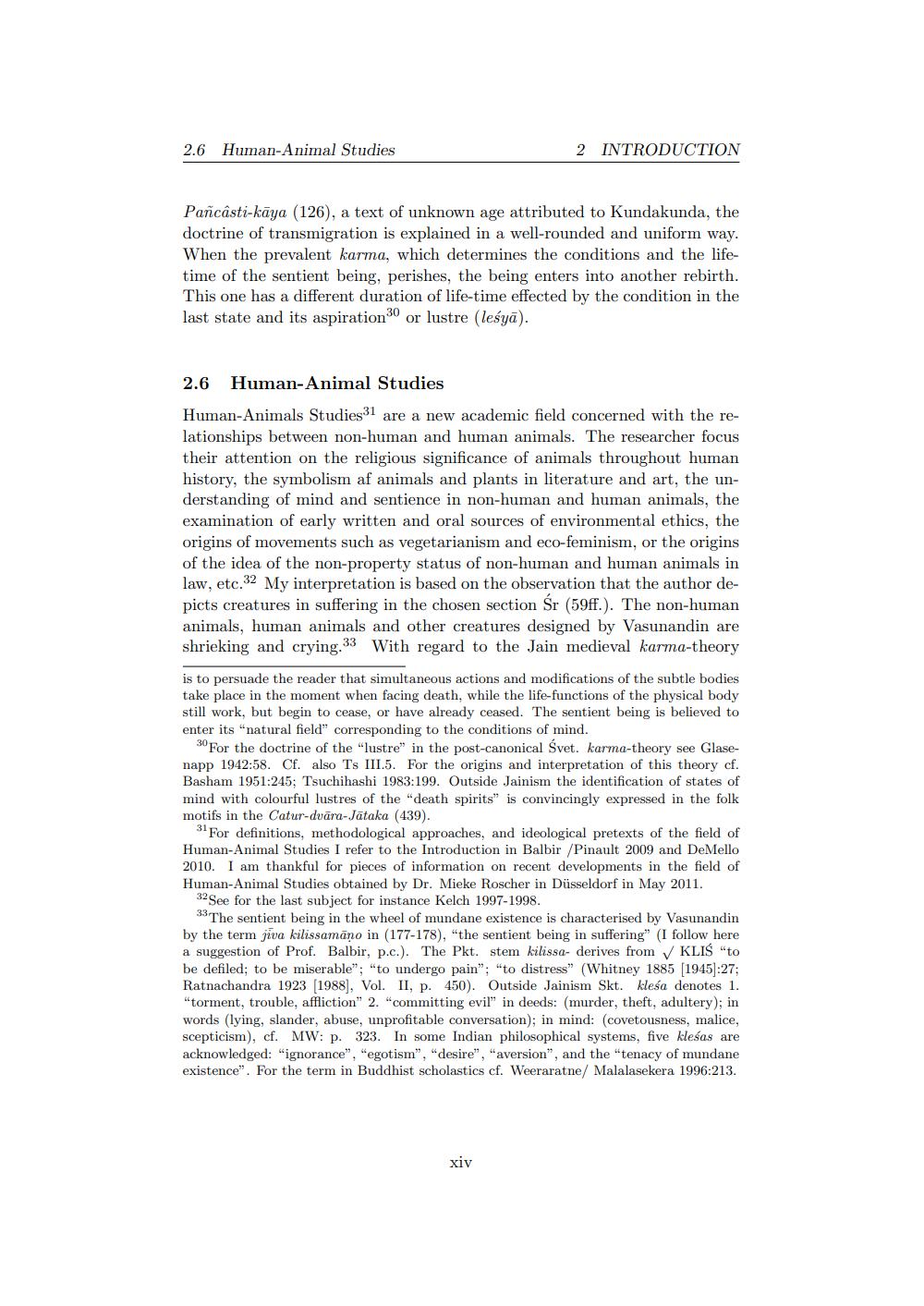________________
2.6 Human-Animal Studies
2 INTRODUCTION
Pañcâsti-kāya (126), a text of unknown age attributed to Kundakunda, the doctrine of transmigration is explained in a well-rounded and uniform way. When the prevalent karma, which determines the conditions and the lifetime of the sentient being, perishes, the being enters into another rebirth. This one has a different duration of life-time effected by the condition in the last state and its aspiration 30 or lustre (leśyā).
2.6 Human-Animal Studies Human-Animals Studies 31 are a new academic field concerned with the relationships between non-human and human animals. The researcher focus their attention on the religious significance of animals throughout human history, the symbolism af animals and plants in literature and art, the understanding of mind and sentience in non-human and human animals, the examination of early written and oral sources of environmental ethics, the origins of movements such as vegetarianism and eco-feminism, or the origins of the idea of the non-property status of non-human and human animals in law, etc.32 My interpretation is based on the observation that the author depicts creatures in suffering in the chosen section Sr (59ff.). The non-human animals, human animals and other creatures designed by Vasunandin are shrieking and crying 33 With regard to the Jain medieval karma-theory
is to persuade the reader that simultaneous actions and modifications of the subtle bodies take place in the moment when facing death, while the life-functions of the physical body still work, but begin to cease, or have already ceased. The sentient being is believed to enter its "natural field" corresponding to the conditions of mind.
30 For the doctrine of the "lustre" in the post-canonical Svet. karma-theory see Glasenapp 1942:58. Cf. also Ts III.5. For the origins and interpretation of this theory cf. Basham 1951:245; Tsuchihashi 1983:199. Outside Jainism the identification of states of mind with colourful lustres of the death spirits" is convincingly expressed in the folk motifs in the Catur-dvāra-Jataka (439).
3 For definitions, methodological approaches, and ideological pretexts of the field of Human-Animal Studies I refer to the Introduction in Balbir /Pinault 2009 and DeMello 2010. I am thankful for pieces of information on recent developments in the field of Human-Animal Studies obtained by Dr. Mieke Roscher in Düsseldorf in May 2011.
32 See for the last subject for instance Kelch 1997-1998.
33 The sentient being in the wheel of mundane existence is characterised by Vasunandin by the term jiva kilissamāno in (177-178), "the sentient being in suffering" (I follow here a suggestion of Prof. Balbir, p.c.). The Pkt. stem kilissa- derives from KLIŚ "to be defiled; to be miserable"; "to undergo pain"; "to distress" (Whitney 1885 [1945]:27; Ratnachandra 1923 (1988), Vol. II, p. 450). Outside Jainism Skt. klesa denotes 1. "torment, trouble, affliction" 2. "committing evil" in deeds: (murder, theft, adultery); in words (lying, slander, abuse, unprofitable conversation); in mind: (covetousness, malice, scepticism), cf. MW: p. 323. In some Indian philosophical systems, five klešas are acknowledged: "ignorance", "egotism", "desire","aversion", and the "tenacy of mundane existence". For the term in Buddhist scholastics cf. Weeraratne/ Malalasekera 1996:213.
xiv




